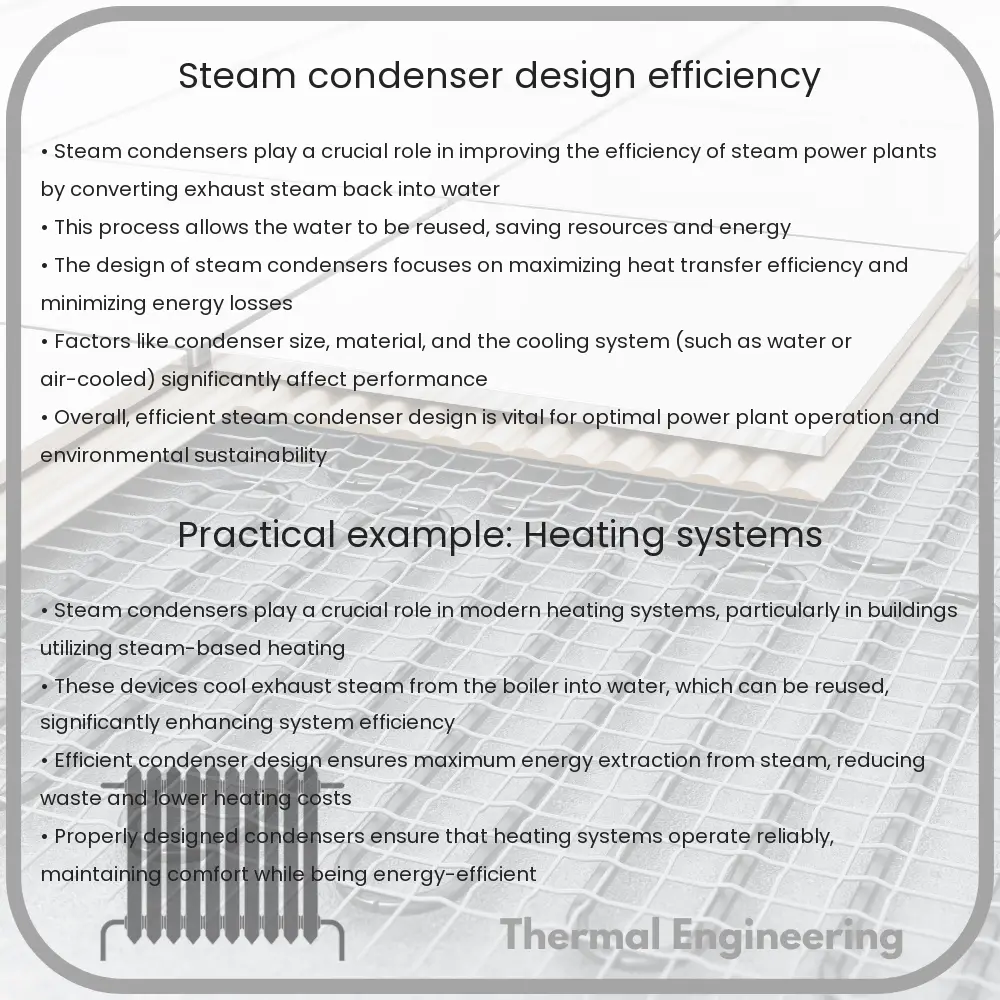Learn about steam condensers, their design, types, operational principles, and efficiency factors critical in power generation and industrial uses.

Understanding Steam Condensers: Design & Efficiency
Steam condensers are critical components in both power generation and industrial processes, serving the primary function of condensing exhaust steam from a steam turbine into water. By converting steam to liquid form, condensers help maintain low turbine back pressure and facilitate the reuse of water, thereby enhancing the overall efficiency of the steam cycle. This article covers the basic design types of steam condensers, their operational principles, factors affecting their performance, and the methods to calculate their efficiency.
Types of Steam Condensers
- Surface Condensers: In surface condensers, there is no direct contact between the cooling water and the exhaust steam. The exhaust steam is condensed on the outside of tubes through which the cooling water flows. It is the most commonly used type in power plants because it allows a high degree of water purity which is often needed for the boilers.
- Jet Condensers (or Direct Contact Condensers): In jet condensers, the cooling water and the exhaust steam come into direct contact. This type is subdivided into parallel flow, counter flow, and mixed flow designs, depending on the direction of the steam and water flow. Jet condensers are typically more compact but do not offer the same level of water purity as surface condensers.
- Air-cooled Condensers: These condense steam on finned tubes by air, which is either natural or forced by fans. This type is particularly used in situations where water usage needs to be minimized or where water disposal is challenging.
Design Considerations
When designing steam condensers, several factors need to be considered to ensure effectiveness and efficiency:
- Materials: The choice of materials, particularly for the tubing, is critical as they need to resist corrosion, withstand high temperatures, and possess adequate thermal conductivity. Commonly used materials include titanium and stainless steel.
- Cooling Water Quality: The quality of the cooling water can significantly impact the condenser’s performance. Impurities in the water can lead to scaling and fouling, which in turn affects the thermal conductivity.
- Condenser Pressure: Lowering the condenser pressure can enhance the efficiency of the steam cycle but requires careful control to prevent negative effects like water ingress into the turbine.
Efficiency of Steam Condensers
Efficiency in steam condensers is primarily determined by their ability to maintain a low temperature of the condensed steam water mixture close to the saturation temperature. The efficiency (\(\eta\)) of a condenser can be expressed by the equation:
\[ \eta = \frac{T_{in} – T_{out}}{T_{in} – T_{sat}} \times 100\% \]
Where:
- \(T_{in}\) is the temperature of the steam entering the condenser.
- \(T_{out}\) is the temperature of the condensed liquid at the outlet of the condenser.
- \(T_{sat}\) is the saturation temperature corresponding to the pressure inside the condenser.
This equation highlights the importance of maintaining a low outlet temperature and a minimal temperature difference between the outlet condensed water and the saturation temperature.
Conclusion
Steam condensers are crucial for the efficiency and effectiveness of steam power cycles, significantly influencing operational costs and environmental impact. With a comprehensive understanding of the different designs, material considerations, operational challenges, and calculation of efficiency, engineers can optimize condenser performance to meet energy production needs while adhering to environmental standards and economic constraints.